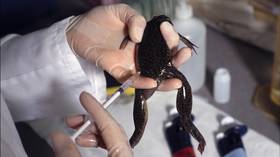Scientists test drugs to regrow amputated leg

A group of scientists has been able to kickstart regenerative processes in African clawed frogs with a wearable bioreactor infused with a mixture of drugs, a new study published by the Science Advances journal on Wednesday shows.
The study was performed by scientists from Tufts University and Harvard University’s Wyss Institute, and involved around 115 African clawed frogs (Xenopus laevis). Unlike some other amphibians, such as salamanders, which can fully regenerate lost limbs, frogs have limited regenerative potential.
The frogs, which had their right hind leg amputated, were separated into three groups, with the control group receiving no treatment at all. Another group was given a wearable bioreactor device developed by the research team earlier, called the BioDome. The device is a silicon regenerative sleeve, with its inner layer containing silk from silkworms, processed into a polymer called hydrogel.
The third group also received the BioDome, but was infused with a cocktail of five drugs on top of that. Each drug had a different purpose, ranging from reducing inflammation to slowing down development of scar tissue, and kickstarting the growth of nerves and blood vessels. The device was fitted for only a 24-hour-period, after which the frogs were observed for 18 months by the scientists.
While the control group grew a basic ‘spike’ – a long featureless stump, the frogs with the BioDome developed longer and more sensitive spikes. The lucky frogs that received the drug-infused device were able to grow a functioning limb.
“The new limbs had bone structure extended with features similar to a natural limb’s bone structure, a richer complement of internal tissues, including neurons, and several ‘toes’ grew from the end of the limb, although without the support of underlying bone,” Tufts University said in a press release.
The regrown limb appeared to be fully functional, with the amphibians using it for swimming, pushing, and orienting themselves in water. “None of us can say what it feels like to be a frog [with a new limb], but from what we can measure, there were no differences compared to a non-injured limb,” Michael Levin, a scientist with Tufts University, said.
With the successful research conducted in frogs, the scientists now plan to shift their efforts to mammals, which generally have lower regenerative capabilities than amphibians. “We’ll be testing how this treatment could apply to mammals next,” Levin revealed.













